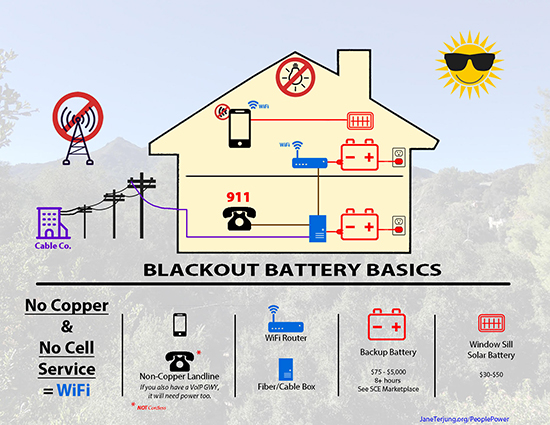Backup Batteries for Blackouts | |
Backup Batteries for BlackoutsHome batteries don’t need solar…but it helps!
The recent winter storms in Texas brought home the serious problems created when the power is down for days, even weeks. The LA Times reported tens of thousands of homes were affected, and one of the worst cases was a woman living with her cats whose refrigerator was off for nearly a week, who said, “All the food in my fridge went bad and I was looking to open the cans of cat food for myself!”
This could easily happen here, as Southern California Edison (SCE) has informed us that on Red Flag Days (high wind with dry conditions in high fire danger areas) they will turn off power for up to five days in Topanga and Malibu.
In early January, the utilities warned 15,000 homes about blackouts; the following week they threatened 26,000 homes. Several neighborhoods were directly affected: Simi Valley had seven hours without electricity; Moorpark had three continuous days with six-hour shutdowns; and Thousand Oaks had 36 hours without power, lights, Internet, TVs, or refrigerators. In a blackout, with no copper landline phone, small batteries can power your cable box, so you can use your cable landline phone, and your router for your cell phone with WiFi via internet. |
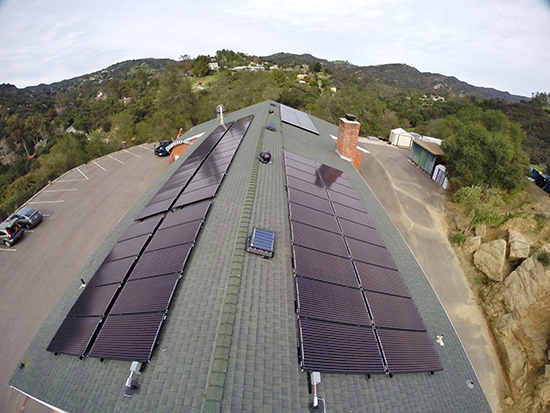 AERIAL DRONE PHOTO BY JOSH The Topanga Community House has 84 panels installed that produce a 22.5-Kilowatt system. Installed by PermaCity Solar. The question is, how can you protect yourself when the blackout occurs in your neighborhood?
The short answer is there are large generators, large battery storage systems refilled every day by solar power and small batteries to keep your cell communication going and there are pros and cons to each.
At press time, Edison was showing a $50 rebate for small generators and a $500 rebate for the larger models. |  PHOTO BY DAN SEEGER The Honda EU2200i. HOME GENERATORS BIG & SMALL
A small portable generator can be purchased for between $500-$1,200 and can run a refrigerator and a few accessories.
“The generator I have is the Honda EU2200i,” says Dan Seeger, who lives in Fernwood. “It’s rated at 2200 watts and weighs 47 pounds. I’ve run two refrigerators, a freezer, a 75-inch TV, the cable box, three internet routers, and my desktop PC at the same time, plus some lighting, and it remained in eco mode. The trick is not to start them all at once, so there’s no sudden power demand.”
Seeger says he paid about $1200 for his generator and around $100 for the companion unit. “The only drawback,” he says, “is that it doesn’t hold much gas, less than a gallon, and may not last the night. (https://marketplace.sce.com/portable-generators)
Advantage
• A small generator needs no electrician to install it and no permits are required.
Disadvantages
• You can run out of gas. They operate on fossil fuels, gasoline or propane. Gas has a limited shelf-life that breaks down over time. (With ethanol added, fuel crystalizes within a few months, so it should be stored separately).
• If a wildfire hits your home the generator may explode and become a fire bomb.
Small Generators have to be pulled out of storage, started, and appliances plugged in by hand (not an easy task).
• They require periodic maintenance to be sure they will start when needed.
• Unenclosed generators are noisy and sound like someone is mowing your lawn non-stop.
• Some have electric starters, but if not run regularly, the starter battery will be dead. These generators are effective, but not the easiest to operate.  | 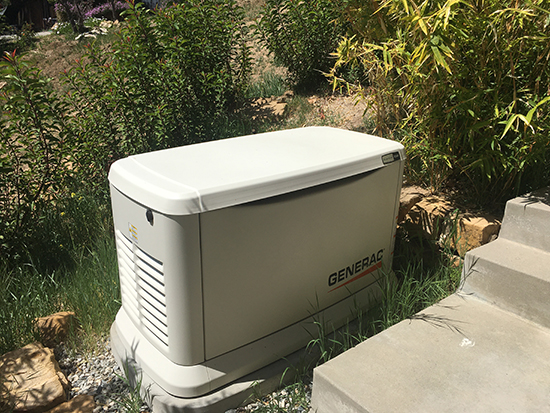 PHOTO BY SHAWN RHODES The Generac is a 100 amp, fully enclosed auto-starting generators, the average size for residential use. It must be permitted, wired, and connected by a professional. FULLY ENCLOSED AUTO-STARTING GENERATORS
“These must be permitted, wired and connected by a professional,” says Topanga electrician Shawn Rhodes (310-455-1332). “If a generator is properly sized to the house, it should be able to run the entire house. The Generac is a 100 amp, the average size for residential use. The costs will range from $10,000 to $15,000 depending on location of gas lines, electrical connections, and permit costs.”
Advantages
• They can run your entire house.
• These will take over automatically in a power outage and are less noisy than smaller un-enclosed models.
Drawback
• They burn fossil fuel and need to be maintained: they should be run twice a month and serviced once a year. However, they are dependable if maintained properly. | 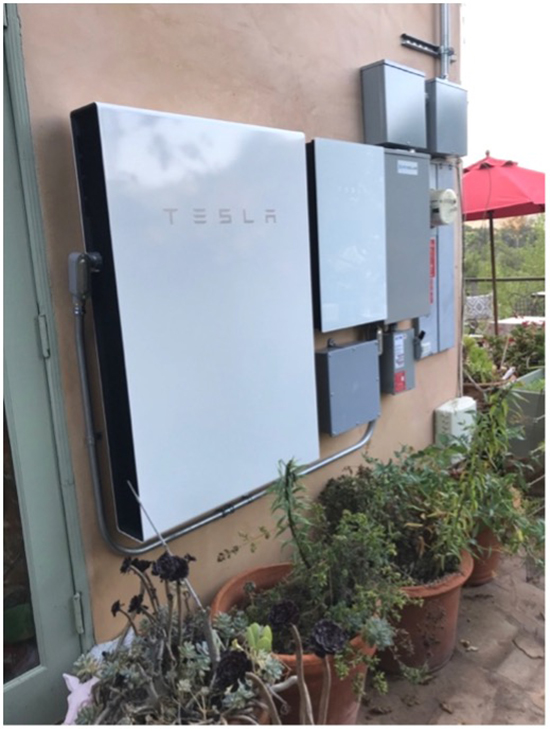 Tesla, the first home battery on the market, is expensive but can be connected to any solar generating system. LARGE-SCALE BATTERY SYSTEMS
TESLA was the first home battery on the market. They are expensive, $16,000 before incentives for a single unit, but Tesla is a recognized storage system as well as the name of the car. A single battery qualifies for a 26% tax credit and about a $2,800 rebate.
Advantages
• Unlike generators they are programmed to store energy in the afternoon to offset expensive peak hour costs (5-8 p.m.) with the new required Time-Of-Use rate.
• Storage Batteries burn no fossil fuels, are quite silent, and no service is required.
• All battery systems carry a 10-year warranty.
• Tesla batteries can be connected to any solar generating system.
Drawback
• Tesla batteries require five to six additional electrical boxes installed next to the Tesla battery box. |  SunPower recently launched their SunVault Storage system that costs about the same as Tesla but delivers 40% more power to run more appliances at the same time. THE LATEST RESIDENTIAL SOLAR STORAGE SYSTEM
SunPower recently launched their SunVault Storage which stores about 13,000 watt-hours of power, but can handle larger amp start-ups like toaster ovens, microwaves, and space heaters. A 26% tax credit plus $2,240 rebate reduces investment to $9,000-$10,000.
Advantages
• The SunVault costs about the same as Tesla but delivers 40% more power to run more appliances at the same time.
• Hub+ Smart Panel: Intelligently connected to provide real-time visibility into home energy use, solar, and storage. It oversees battery usage and the monitor displays on your cellphone.
• SunPower warranties cover the panels and storage system; the unique LFP battery chemistry means greater reliability and stability.
• Simple design: The SunVault has only two pods containing batteries, inverter, emergency panel, and disconnects, as opposed to other Storage Systems that require multiple electrical boxes.
• With an appropriate photovoltaic solar system, a house can operate indefinitely through a power outage.
Available from Smart Solar (now in Thousand Oaks) serving Topanga, Malibu, and West Valley. 818-292-8065; 310-455-2958.  | 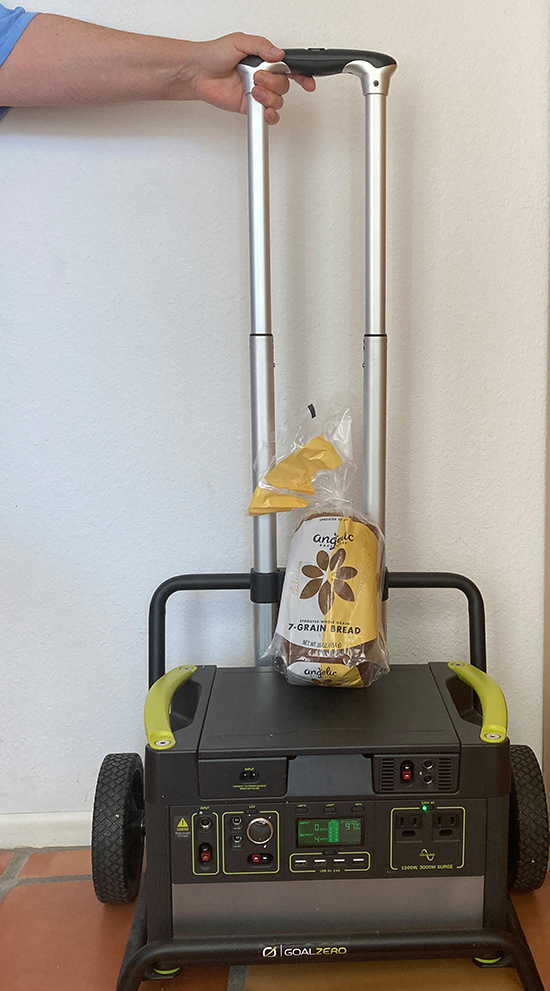 PHOTO BY BILL NAYLOR Goal Zero Yeti 1000 The clean and quiet Yeti is a lightweight 1000 Lithium Portable Power Station that runs small and large electronics, and recharges itself from the sun. Comes in different sizes that range in cost from about $200-$2000. (Bread not included) SMALL-SCALE IS PORTABLE AND AFFORDABLE
Yeti batteries are charged from the grid, or portable solar panels. They are small (like a breadbox), inexpensive, but have limited backup capacity. From $500 to $3,000 one can pull it out of a closet or keep it connect ed and ready to kick-in automatically to power your phones and internet. However, you cannot run a full-size refrigerator or more than a few lights. Along with Yetis, SCE now offers other small solutions that store electricity from your home (many with rebates). goalzero.com/product-features/portable-power-stations; /marketplace.sce.com/portable-power-stations/
Jane Terjung’s List of Affordable Gadgets that Help in a Blackout, such as hand-crank/solar radios, solar windowsill batteries, and outdoor solar charging panels, is available at: janeterjung.org/docs/Cool%20Gadgets%20For%20PSPS.pdf.
Lee Rhoads has 12 years’ experience with solar and storage (including the Topanga Community House). leesolarconsulting@gmail.com; (310) 455-2958, home/office; (310) 487-5750, mobile.  | | | | | | | | | |
|
|
|
|
|
|
|
 |
|
|
|
| | |
|
|




